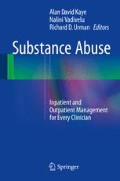Abstract
Relaxation techniques have been around as long as there has been stress in people’s lives. When stressful situations present themselves whether one takes deep breaths to relax, meditates, or imagines a pleasant place or experience, these methods have been in existence since the beginning of time. Although these techniques, or training for relaxation, have been in existence it has only been recently that the western medical community has been accepting them. Now that the greater medical community has gained acceptance of these relaxation techniques, many practitioners find it difficult to understand the utility and/or how to incorporate these methods into treatment plans. This chapter will help educate and guide medical practitioners about relaxation techniques and how they can be implemented in one’s treatment plans and goals.
Access this chapter
Tax calculation will be finalised at checkout
Purchases are for personal use only
References
Sierpina V, Levine R, Astin J, Tan A. Use of mind-body therapies in psychiatry and family medicine faculty and residents: attitudes, barriers, and gender differences. Explore (NY). 2007;3:12.
Stetter F, Kupper S. Autogenic training: a meta-analysis of clinical outcome studies. Appl Psychophysiol Biofeedback. 2002;27(1):45–98.
Lynn S, Fassler O, Knox J. Hypnosis and the altered state debate: something more or nothing more? Contemp Hypn. 2005;22:39.
Coe W, Buckner L, Howard M, Kobayashi K. Hypnosis as role enactment: focus on a role specific skill. Am J Clin Hypn. 1972;15(1):41–5.
Lynn SJ, Rhue JW, editors. Theories of hypnosis: current models and perspectives. New York: Guilford; 1991.
New definition: hypnosis division 30 of the American Psychological Association.
Newmark TS, Bogacki DF. The use of relaxation, hypnosis, and imagery in sport psychiatry. Clin Sports Med. 2005;24(4):973–7.
Begel D, Burton RW. Sports psychiatry: theory and practice. New York: W. W. Norton & Company; 2000.
Segi S. Hypnosis for pain management, anxiety and behavioral disorders. Factiva. Retrieved December 7, 2012.
Brink TL. Psychology: a student friendly approach. Unit 5: perception; 2008, p. 88.
Kirsch I. Clinical hypnosis as a non-deceptive placebo: empirically derived techniques. Am J Clin Hypn. 1994;37(2):95–106.
Kirsch I. Clinical hypnosis as a non-deceptive placebo. In: Kirsch I, Capafons A, Cardeña-Buelna E, Amigó S, editors. Clinical hypnosis and self-regulation: cognitive-behavioral perspectives. Washington, DC: American Psychological Association; 1999. p. 211–25.
Barrett D. Deep trance subjects: a schema of two distinct subgroups. In: Kunzendorf R, editor. Imagery: recent developments. New York: Plenum; 1991. p. 101–12.
Barrett D. Fantasizers and dissociaters: an empirically based schema of two types of deep trance subjects. Psychol Rep. 1992;71(3 Pt 1):1011–4.
Barrett D. Fantasizers and dissociaters: two types of high hypnotizable, two imagery styles. In: Kuzendorf R, Spanos N, Wallace B, editors. Hypnosis and imagination. New York: Baywood; 1996.
Feuerstein G. The Shambhala guide to yoga. Boston: Shambhala; 1996. p. 26.
Quittner A, Glueckauf R. The facilitative effects of music on visual imagery: a multiple measures approach. J Ment Imagery. 1983;7:105–19.
Band JB. The influence of selected music and structured vs. unstructured inductions on mental imagery. Unpublished doctoral dissertation, University of South Carolina; 1996.
McKinney C, Tims F. Differential effects of selected classical music on the imagery of high versus low imagers: two studies. J Music Ther. 1995;32:22–45.
Burns D. The effects of the bonny method of guided imagery and music on the mood and life quality of cancer patients. J Music Ther. 2001;38:51–65.
West M, editor. The psychology of mediation. Oxford: Clarendon; 1987.
Manocha R. Why meditation? Aust Fam Physician. 2000;29:1135–8.
Cardosos R, de Souza E, Camano L, et al. Meditation in health: an operational definition. Brain Res Protocol. 2004;14:58–60.
Arias AJ, Steinberg K, Banga A, Trestman RL. Systematic review of the efficacy of meditation techniques as treatments for medical illness. J Altern Complement Med. 2006;12:817–32.
Ross A, Thomas S. The health benefits of yoga and exercise: a review of comparison studies. J Alternative Compl Med. 2010;16(1):3–12.
Javnbakht M, Hejazi Kenari R, Ghasemi M. Effects of yoga on depression and anxiety of women. Complement Ther Clin Pract. 2000;15(2):102–4.
Smith C, Hancook H, Blake-Mortimer J, Ecker K. Randomized comparative trial of yoga and relaxation to reduce stress and anxiety. Complement Ther Med. 2007;15(2):77–83.
Thomas RA. The health benefits of yoga and exercise: a review of comparison studies. J Altern Complement Med. 2010;16(1):3–12.
Hayes M, Chase S. Prescribing yoga. Prim Care. 2010;37(1):31–47.
Alexander GK, Taylor AG, Innes KE, Kulbok P, Selfe TK. Contextualizing the effects of yoga therapy on diabetes management: a review of the social determinants of physical activity. Fam Community Health. 2008;31(3):228–39.
Gooneratne NS. Complementary and alternative medicine for sleep disturbances in older adults. Clin Geriatr Med. 2008;24(1):121–38.
Silverberg DS. Non-pharmacological treatment of hypertension. J Hypertens Suppl. 1990;8(4):S21–6.
Labarthe D, Ayala C. Nondrug interventions in hypertension prevention and control. Cardiol Clin. 2002;20(2):249–63.
Smith K, Pukall C. An evidence based review of yoga as complementary intervention for patients with cancer. Psychooncology. 2009;18(5):465–75.
Khalsa SB, Khalsa GS, Khalsa HK, Khalsa MK. Evaluation of a residential Kundalini yoga lifestyle pilot program for addiction in India. J Ethn Subst Abuse. 2008;7(1):67–79.
Yoga’s ability to improve mood and lessen anxiety is linked to increased levels of a critical brain chemical, research finds. Sciencedaily.com. 2010:11–12.
Deutsche Gesellschaft Für Allgeminmedizin (DEGAM). Leitlinie Nr. 13- Nachenschmerzen; 2009.
Craske M, Barlow D. Worry. New York: Oxford University Press; 2006. p. 53.
Author information
Authors and Affiliations
Corresponding author
Editor information
Editors and Affiliations
Rights and permissions
Copyright information
© 2015 Springer Science+Business Media New York
About this chapter
Cite this chapter
Hubbard, K., Falco, F.J.E. (2015). Relaxation Techniques. In: Kaye, A., Vadivelu, N., Urman, R. (eds) Substance Abuse. Springer, New York, NY. https://doi.org/10.1007/978-1-4939-1951-2_26
Download citation
DOI: https://doi.org/10.1007/978-1-4939-1951-2_26
Publisher Name: Springer, New York, NY
Print ISBN: 978-1-4939-1950-5
Online ISBN: 978-1-4939-1951-2
eBook Packages: MedicineMedicine (R0)

